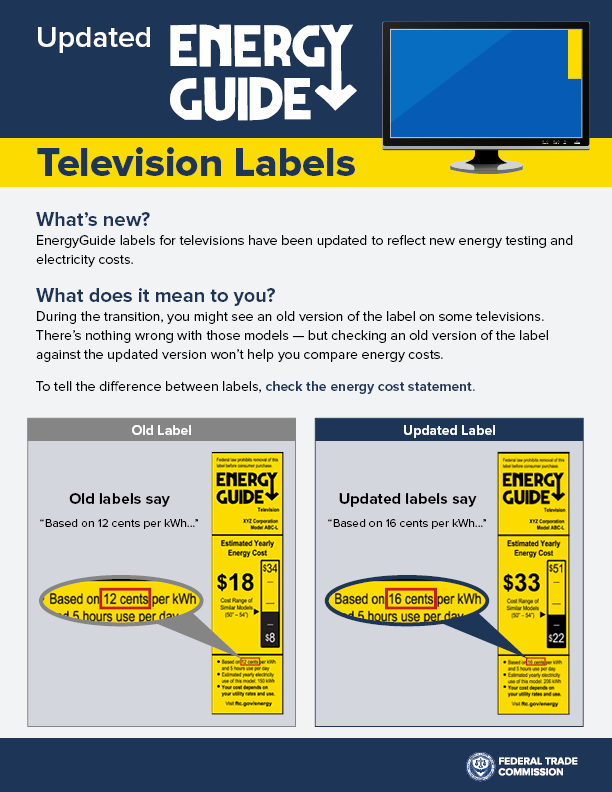There’s been a development in the world of television, but it has nothing to do with who’s starring or what’s streaming. It’s about an important consideration for consumers to keep in mind when shopping for a new TV – and helpful information businesses can provide to prospective customers.
The FTC’s Energy Labeling Rule requires manufacturers of covered products to disclose the energy consumption or energy efficiency of its models at the point of sale. The EnergyGuide labels give consumers key information for comparison shopping. For example, a $600 widget may be a more economical choice than a competing $500 widget if the pricier model has lower energy costs. The specific dollar amounts on the label are derived from Department of Energy test procedures. What’s more, the labels include a “range of comparability” indicating the lowest and highest numbers for comparable models.
Based on updated DOE testing, the FTC recently amended the Energy Labeling Rule to include revised “range of comparability” numbers for televisions. For example, for smaller 24”-29” screens, the new annual energy cost ranges run from $5 to $15. But what about those basement behemoths that are 69.5” or larger? The revised range now runs from $32 to $155. Do the math for several seasons of March Madness, award shows, football games, and bingeable dramas, and those numbers can really add up.
The good news for consumers is that the amended Energy Labeling Rule for TVs takes effect on May 2, 2024. That’s when manufacturers must begin using the new ranges on labels for newly-produced products, giving shoppers an updated tool for comparison shopping the true cost of a TV.
But there’s a caveat. As the transition is underway, consumers may see TVs with the older label next to TVs with the new label. Both may be great products, but because the ranges have changed, consumers won’t be able to make a head-to-head comparison of the energy cost of a TV made when the earlier ranges were in effect versus a TV covered by the amended Rule. How can people know which version of the label they’re looking at? The old version uses the phrase “Based on 12 cents per kWh,” while the new version uses the phrase “Based on 16 cents per kWh.”
As the transition takes place, the FTC has created a downloadable infographic to help industry members explain to consumers what’s going on with the EnergyGuide labels for TVs. Consider making them available at the point of sale in stores and online and having them on hand if people have questions. We see it as a useful service that can help transform a shopper into a customer.

It is your choice whether to submit a comment. If you do, you must create a user name, or we will not post your comment. The Federal Trade Commission Act authorizes this information collection for purposes of managing online comments. Comments and user names are part of the Federal Trade Commission’s (FTC) public records system, and user names also are part of the FTC’s computer user records system. We may routinely use these records as described in the FTC’s Privacy Act system notices. For more information on how the FTC handles information that we collect, please read our privacy policy.
The purpose of this blog and its comments section is to inform readers about Federal Trade Commission activity, and share information to help them avoid, report, and recover from fraud, scams, and bad business practices. Your thoughts, ideas, and concerns are welcome, and we encourage comments. But keep in mind, this is a moderated blog. We review all comments before they are posted, and we won’t post comments that don’t comply with our commenting policy. We expect commenters to treat each other and the blog writers with respect.
- We won’t post off-topic comments, repeated identical comments, or comments that include sales pitches or promotions.
- We won’t post comments that include vulgar messages, personal attacks by name, or offensive terms that target specific people or groups.
- We won’t post threats, defamatory statements, or suggestions or encouragement of illegal activity.
- We won’t post comments that include personal information, like Social Security numbers, account numbers, home addresses, and email addresses. To file a detailed report about a scam, go to ReportFraud.ftc.gov.
We don't edit comments to remove objectionable content, so please ensure that your comment contains none of the above. The comments posted on this blog become part of the public domain. To protect your privacy and the privacy of other people, please do not include personal information. Opinions in comments that appear in this blog belong to the individuals who expressed them. They do not belong to or represent views of the Federal Trade Commission.
Hello, To Whom Reads This
Why don't the labels on those devices have the amount saved with solar panels since the new reform on the green act that should allow some savings not just on homes and tax's but also reflect the kick it receives from such products that help conserve energy and informs potential. They can be comparable to the solar market but solar is still freelance endorsed so it is not prompting a company for profit just informing the full rage of the TV performance.
Best Wishes,
MB.

Add new comment